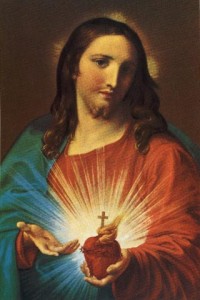The Sacred Heart of Jesus: Source of Limitless Love
 Devotion to the Sacred Heart of Jesus originated as a meditation on the love that Jesus has for humanity. In the 1500s, Jesuits and Franciscans promoted devotion to the wounded heart of Jesus. However, they did not stress the physical bleeding heart of Jesus crowned with thorns that has come down to us. This common image does not necessarily help people feel closer to Jesus today. Presenting Jesus with a heart with flames of love and a face full of love and light emphasizes his limitless divine love in a very human way.
Devotion to the Sacred Heart of Jesus originated as a meditation on the love that Jesus has for humanity. In the 1500s, Jesuits and Franciscans promoted devotion to the wounded heart of Jesus. However, they did not stress the physical bleeding heart of Jesus crowned with thorns that has come down to us. This common image does not necessarily help people feel closer to Jesus today. Presenting Jesus with a heart with flames of love and a face full of love and light emphasizes his limitless divine love in a very human way.
A Physical Organ or A Symbol of Love?
 The devotion to the Sacred Heart has not always included a focus on the suffering of Jesus and his actual physical heart. During the first ten centuries of Christianity, devotion to the humanity of Christ did not include honoring the wounded Heart of Jesus. From the 1200s to the 1500s devotion to the Sacred Wounds increased. However, it was private, individual, and of a mystical nature. The thorn crowned heart shows the change from honoring Jesus’ love for humanity to humans making reparation for sin. In the 1670s, the apparitions of the Sacred Heart of Jesus to Saint Margaret Mary Alacoque, moved the devotion into the public life of the Church and it became centered on sorrow for sin. Popular piety continued this emphasis and eventually promoted worship of the physical heart of Jesus to such a point that Pope Pius XII had to correct this. The pope explained that the Sacred Heart belongs to the “Divine Person of the Eternal Word” and is a symbolic image of his love and our redemption. (See Haurietis aquas). Eastern Catholicism promotes some devotion to the Sacred Heart of Jesus. However, the devotion is controversial because of the mixing of the theologies of divine love and human reparation for sin within it. Eastern Catholics do not share the Western preoccupation with the physical heart of Jesus.
The devotion to the Sacred Heart has not always included a focus on the suffering of Jesus and his actual physical heart. During the first ten centuries of Christianity, devotion to the humanity of Christ did not include honoring the wounded Heart of Jesus. From the 1200s to the 1500s devotion to the Sacred Wounds increased. However, it was private, individual, and of a mystical nature. The thorn crowned heart shows the change from honoring Jesus’ love for humanity to humans making reparation for sin. In the 1670s, the apparitions of the Sacred Heart of Jesus to Saint Margaret Mary Alacoque, moved the devotion into the public life of the Church and it became centered on sorrow for sin. Popular piety continued this emphasis and eventually promoted worship of the physical heart of Jesus to such a point that Pope Pius XII had to correct this. The pope explained that the Sacred Heart belongs to the “Divine Person of the Eternal Word” and is a symbolic image of his love and our redemption. (See Haurietis aquas). Eastern Catholicism promotes some devotion to the Sacred Heart of Jesus. However, the devotion is controversial because of the mixing of the theologies of divine love and human reparation for sin within it. Eastern Catholics do not share the Western preoccupation with the physical heart of Jesus.
Devotion to Love
 Devotion to the Sacred Heart of Jesus is a devotion to His love. It is a response to the extravagance of Jesus. His suffering and human sin are important for our consideration in other ways. However, this focus is not suitable for a devotion which focuses on love. This is particularly true today when addressing young people in first world cultures in which few symbols are shared. A heart in flames is a direct and simple symbol.
Devotion to the Sacred Heart of Jesus is a devotion to His love. It is a response to the extravagance of Jesus. His suffering and human sin are important for our consideration in other ways. However, this focus is not suitable for a devotion which focuses on love. This is particularly true today when addressing young people in first world cultures in which few symbols are shared. A heart in flames is a direct and simple symbol.
It is interesting that one of the main resources of devotion to the Sacred Heart, the Litany of the Sacred Heart of Jesus (1899), is anything but human, warm, or loving. The Litany is formal, monarchical and transcendent. There is little sense of the human heart of Jesus reaching out to humanity to give consolation, peace or special graces. The prayer is true to its historical context, a time in the Church of formality and a sense of distance from the divine.
Despite the turn towards human individual experience and emotion in the 20th and 21st centuries, many Catholics do not feel personally close to God or have a warm experience of God’s love for them. Many still relate to God as a judge and an enforcer of rules. Contemplating Jesus in the Gospels gives us a richer mystical image of the truly divine and truly human Jesus Christ full of warm friendliness, compassion, and humility with a heart full of love.
Sacred Heart of Jesus, by David Clayton – used with permission
Sacred Heart, by Pompeo Batoni – public domain
Sacred Heart of Jesus, by Joseph Fanelli – used with permission









